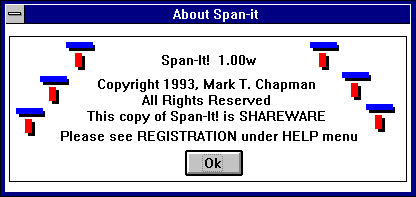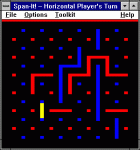Span-It! 
Rarely does a game’s title explain its entire premise. In Span-It!, there is a board. And you must span it.
Even with the hilariously simple premise, Span-It! contains enough options and tweaks to stretch out its worth and replay value. But they also reveal a few major strategic shortcomings that makes the single-player mode wear thin quickly.
Players take turns drawing lines on a diamond grid with the goal of completing an unbroken line across the playing field (one player goes horizontally, the other vertically). Defense becomes as important as offense; blocking the other player’s lines is an essential strategy, occasionally the last resort and only option for whoever starts second. On larger playing fields (the default size of 6 spaces can go up to 20), this leaves room for countermeasures, thinking ahead of the enemy, and juggling multiple possible endgames. Much like chess, you can see your opponent’s strategy forming several moves in advance… if you take Span-It! really, really seriously.
Besides the hotseat multiplayer mode, the game includes a number of tweakable AI profiles with different levels of predictability, anticipation, path splitting, and contingency planning. The variables mostly boil down to making the computer more offensive or defensive. Unfortunately, this reveals a significant hole in the game’s strategy. Based on a few tests playing AIs against each other, defensive opponents that block will nearly always win against aggressive ones, especially when they start second. The same thing holds true when a human plays against the computer; offensive opponents take much less effort to beat.
With that in mind, Span-It! is more fun against human opponents. Like many games (again… like chess), fighting against another person who’s constantly calculating and rethinking their next move brings out the game’s strengths and hides the problems that its mechanical, predictable AI glaringly point out.


